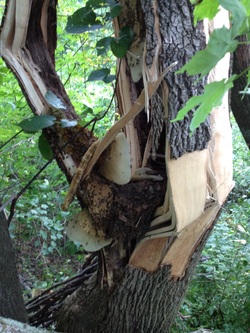 While our July 4th staycation was not quite Hugh Grant worthy, it was quite dramatic by our standards. The prior Friday our area experienced a derecho storm that knocked out our electricity along with millions of others in Indiana, Ohio, West Virginia, Maryland and Virginia. Just when our power was restored we were hit with another hard hail storm on Sunday that had us bringing out the candles. Our staycation appeared destined to take a rustic theme. As rough as we had it during a few days of pioneer style life with temps in excess of one hundred degrees, the storms brought devastation to many of the feral bee colonies in our area. A fellow hobby farmer contacted us on Monday to investigate some damaged bee trees on her farm. She didn't know that she had any feral bee colonies, but when assessing her storm damage she discovered that she had three bee trees that had fallen on her fences and trails. On quick inspection two of the trees were nearly destroyed. What wasn't destroyed by the trauma of collapse was finished off by the sweltering heat and open exposure. The third colony had fared much better having fallen with the cavity mostly undamaged. We celebrated Independence Day by liberating the farm's surviving bees from their destroyed home. For the two most heavily damaged trees, there wasn't much to salvage. We cut out the viable comb and brood and attempted to trap a few hundred bees still in the ruptured cavity. The third tree represented our first attempt at a realistic rescue. Our initial plan was to cut the log above and below the cavity, transport the log in tact to our bee yard, and deal with a trapout or cutout at our convenience. Unfortunately a quick check with a drill proved that most of the tree, at least a 12 foot section, was hollow or rotten and my first cut clipped the bottom of the combs. This was proving to be a bit more complicated than hoped and we moved into a full scale cutout. We attempted to remove as much comb from the cavity as we could reach, cut that section of the tree, and dumped the bees onto a light colored sheet in front of our transport box. We worked our way up the cavity a section at a time. We were very fortunate to spot the queen on the sheet during one of the dumps. We quickly scooped her up and deposited her in the box on the cutout comb. With brood comb and the queen inside the box, the bees became much more cooperative moving into the capture box. After a few hours we had salvaged most of the comb. The capture box was left at the entrance site of the fallen log overnight. Early the next morning we stapled hardware cloth over the entrance and headed home with rescued feral bee colony in tow. That would have been enough excitement for any week, but we're talking about a staycation here. On Friday one of the elder statesmen of the beekeeper's association phoned us. He has been doing swarm removals, cutouts and trapouts in our county longer than I have been alive. At our last association meeting we had discussed some feral colonies in our area and he was happy to find others in the club that were interested in swarms and feral colony collections. He had been contacted about a swarm at a nearby high school and a fallen bee tree at the city country club. The excessive temperatures proved too much for him so he provided us with the contact information for both if we were interested. The swarm collection was straightforward enough. A small secondary swarm had set up on the side of a brick wall near a downspout about 18 inches off the ground. My first attempt at this collection didn't take and upon return the bees had resettled on the wall. I added a frame of drawn comb with eggs to entice them to settle in the swarm box. The frame of comb and eggs did the trick and on Sunday morning we had added our second colony of the week. Turns out the swarm queen was lost before or during the collection and we ended up with a frame of queen cells, but that's a topic for a future update. Our attempt to rescue the bees from the country club bee tree was less fruitful. We had to wait for the operations team to prep the site. By the time we were able to execute the cutout, most of the bees had absconded and the brood has started to decay. We were able to remove the comb from the tree and clear away the few hundred remaining bees at the site. We hadn't planned to spend our staycation with two power outages, the warmest temperatures in over six decades, cutting out four bee trees and collecting a swarm, but it certainly made for a memorable holiday. We now have five colonies in our apiary; one from a swarm trap, two from swarm collections, one from a house cutout and one from a bee tree cutout. Multiple mite infestations and Colony Collapse Disorder have dramatically reduced the feral bee population in our country, wiping out much of the bees' genetic diversity. Maintaining active feral colonies and rescuing those in jeopardy is critical to sustain what little diversity is left from the honey bee's four centuries on our continent. We're thrilled that we had the chance to rescue the colonies we could. If you know of a feral bee colony, please take the time to register their location with the Feral Bee Project at http://www.savethehives.com/fbp/Home.html. If you have a fallen bee tree or colony that needs removal, contact your local beekeeper's association to locate a beekeeper or removal specialist.
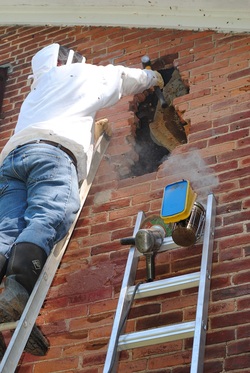 "Go big or go home." I've heard that saying a lot over the years and never really thought it applied to many of my personal endeavors. In retrospect I think that may be an appropriate description of this past Sunday's adventure. This weekend we went on our first honeybee colony cutout call. "Cutout" is the term used to describe to process of removing an established bee colony from a building or structure. You literally cut (or bash or pry) open the walls or ceiling of the structure and remove the comb and bees. Our cutout came as a response to an email sent by our beekeeper's club.
A woman in a nearby neighborhood had a honeybee colony that had taken up residence inside the brick walls of her home. She believed that they had moved in as a swarm earlier this spring. She wasn't having much luck finding someone that would remove the bees without killing them. One of the officers in the club sent us a inquiry asking if we would be willing to assist her. We had some spare time available on Sunday so I (perhaps in a moment of insanity) offered to drive by her home and assess the situation.
The colony had established itself inside an old walled off chimney cavity in the brick home. The cavity was about 24 inches wide by 12 inches deep and two stories tall. An all around perfect home for a colony of honeybees. The brick and mortar up the cavity were riddled with small openings and the bees were using two or three of them as an entrance. The primary entrance was about 12 feet off the ground where a section of mortar had fallen out.
While I'm trying to learn the art of beekeeping, a carpenter I am not! I told her she had a few options. She could call a professional cutout and removal service that would remove the bees and repair the structure. I'm no pro at this but I estimated it would likely cost in the range of $500 and could be up to $1000 depending on the size of the colony and repair job. I am not aware of one in our county but there are a few listed in the broader metro area. I then volunteered to help remove the bees if she was okay with me simply tearing away the deteriorating brick covering that part of the abandoned chimney cavity. She would need to contact a mason on her own to manage the repairs once the site was bee-free. I wanted to get the experience of a cutout while attempting to help anyone interested in saving vs. destroying the bees. She jumped on the deal.
Sunday morning my wife and I trooped over to her home to get started removing the "3 to 4 week old swarm" that was in the wall. The first small opening revealed the bottom of the combs. Layer after layer of brick came out while larger areas of comb were exposed. After 30 minutes on the job it became clear this wasn't a late spring swarm. These girls have been busy building up their home for at least a couple of years. After more than an hour of opening the wall we exposed 6 combs about 3 feet tall by 10 to 12 inches wide. They were much better carpenters than me and you can't help but admire the beauty of their handiwork. I started Sunday expecting to collect a meager box of bees and left with a deep box full of brood, honey and bees.
Had I known that this colony had been established for several years I suspect I wouldn't have agreed to help so eagerly. But as they say, "go big or go home." Experience is what I wanted, and experience is what I got. The cutout went smoothly despite some of my rookie mistakes. I have not yet spotted the queen to confirm that she survived the extraction. I suspect we'll know in a few days upon inspection if she is there or if the colony is attempting to build emergency queen cells on some of those eggs in the brood comb. I had to make 3 follow up trips to collect more bees and I inadvertently dropped many down the chimney cavity whilst trying to collect them for transport. The homeowner had a great attitude and I suspect she'll end up becoming a beekeeper, albeit with bees in a hive instead of her home. And finally my wife was on board for the experience and was a cheerful co-conspirator in spite of having a brick dropped on her foot from above by yours truly. Most spouses would have considered the idea outright madness. She not only supported the idea, she was as deep in those bees as I was. For that I am truly a fortunate man.
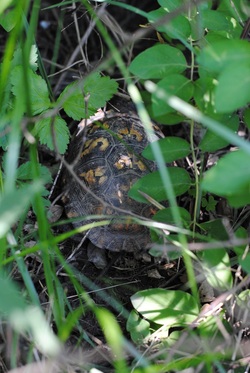 At a recent garden party (perhaps that term is a bit too formal for a group of couples hanging out eating pizza while the kids run around like wild animals), part of the conversation covered the host’s lovely vegetable garden. I’ll admit to some envy at the size and beauty of the tomato plants in the organized suburban garden setting, compared to the young scrappy looking vines out in my rural plot. During the chat discussion shifted to slug control measures. It seems that the beer traps work well, but require continued vigilance. Grapefruit halves and egg shells were mentioned as other effective methods but no one seemed to have direct experience with those techniques. I left the conversation intrigued and newly aware that we haven’t had any slug issues this year. That sparked my curiosity.
Don’t get me wrong, I have found an occasional slug in the garden, but nothing that would cause concern. There are many potential reasons why slugs might not be a pest problem in my garden while our fellow party goers were exploring control methods a few miles away. Microclimate, garden location, orientation to the sun, soil moisture, shading, nearby structures and soil composition are just a few of the possibilities. My favorite answer, and most probable one, is predation. In one of my earlier blog entries I shared a photo of a toad sitting in the newly constructed hugelkultur garden bed. A few weeks ago my wife spotted a turtle lounging under the shade a few feet from that same garden. Toads and turtles love to eat slugs. I suspect these guys are dispatching the slugs before they do much damage or I get the opportunity to view them. On our property, that toad has several brothers, sisters and cousins living near the small stream, in the natural drainage channels, in the landscape beds and in our multiple vegetable plots. The more slugs, the more toads can move into the area to eat. While toads and turtles might not seem like predators from my viewpoint, I suspect they are high on the list of threats to a slug. But why we don’t have toad infestation problems? I suspect the slug to toad / turtle population has reached a point of stasis or the raccoons, coyotes and hawks have created a similar balance with the toad as prey.
Natural ecosystems are all about long term balance. Slug or toad infestations will occur periodically. One species may rise to infestation level in an area for a period of time. Any system will have occasional variances, but a well-balanced system will self-modify and self-correct. Predators often play the critical role in ecosystems. Population explosions by one species will eventually attract its predators and parasites. Those predators themselves may grow in population but this should balance as the food source disappears or new predators and parasites emerge to prey upon the new imbalance.
Permaculture is a systems based approach to agriculture. Plants and animals are selected to play a role within the community toward a goal of symbiosis and balance. Diversity and polycultures are preferred over monocultures. The clover used as ground cover attracts pollinators and fixes nitrogen for other plants in system. Some species are chosen to draw nutrients deep in the soil near the surface where it can be accessed by others. Helpful insects and wildlife are encouraged to thrive along with useful livestock management. Even the litter and waste serves an important purpose in the system. Preference is given to perennial or self-propagating species toward a long term self-sustaining system.
Within the permaculture community, some are experimenting with the transfer of these concepts from the fields and forests into human society. At first blush that seems a little hippie or libertarian to me (I’m a moderate at heart), but from a systems thinking standpoint I can’t help but be drawn to the concept. Upon reflection it doesn’t seem that different than the last hundred thousand years of human society, with the notable exception of the last few hundred years. I also can’t help having misgivings over the impact of human population expansion and impact within our ecosystem. Natural systems seem to find ways to self-modify and self-correct to reach stasis.
We humans are an intelligent species. Perhaps we’re intelligent enough to maintain and sustain an out of balance system. For some reason I’m doubtful that we’re that intelligent. I am hopeful that we are smart enough to find ways to create more balance and some sort of stasis so nature doesn’t take things into her own hands. The likely result ends up with nature treating us like another population infestation, rebalancing population levels through food shortages, predators / parasites or outright extinction.
As for our little forty acre slice of earth, I’m going to try to take as much pleasure in the coyote, hawk and raccoon as I do in the toads, turtles and turkeys. That won’t be easy. I suppose we could end up losing some of our chickens or even one of our dwarf goats. The kids will cry. I'll be frustrated. But the coyotes are just being coyotes, playing their role in the ecosystem. They have moved here to Ohio because we no longer have red wolves. While the bobcat still lurks in some southern Ohio forests, the only Ohio bobcat most of us will see in a lifetime is the one on a collegiate sweatshirt. So when I see those predators I'll try to pause, recall those permaculture concepts and try to take solace in the fact that the higher predators are a sign of a healthy and balanced ecosystem.
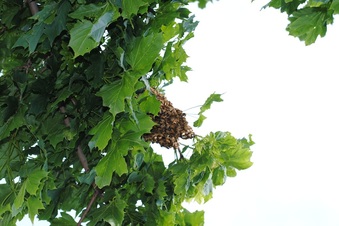 One of the rights of passage for a beekeeper is the swarm call. That's the call from a neighbor, friend, or random citizen to announce that they have a swarm on a tree (or swing, building, lamppost) inciting terror in passersby. The caller is usually looking for someone to remove the perceived threat and may have first summoned an exterminator only to learn to exterminators can only kill honeybee swarms under extreme circumstances in most states. The reality is that swarms (of non-africanized bees) are incredibly docile and a true wonder of nature.
This week we got our first swarm call and passed our initiation into the world of beekeeping. Our call came from our mentor and president of the local beekeepers club. A small swarm had set up temporary residence on a tree in the parking lot outside the main entrance of a local food processing plant. The company's pest management firm had contacted the beekeepers association to identify a local resource to remove the swarm. We turned out to be the closest club members to the location and were known to be looking to add a second colony to our apiary. After a quick call to the business facilities team we scheduled to attempt the swarm collection late afternoon / early evening if the swarm hadn't relocated by then.
Upon arrival at the site we set up a light colored sheet underneath the swarm, placed a 5 frame Nuc box on the sheet, donned our gear and got about our business. The process of removing the swarm was simple enough. We misted the swarm and the entrance to the Nuc box with a 1:1 mixture of sugar and water, climbed a step ladder, pulled down the branch containing the swarm as low as possible, and gave it a couple of quick hard shakes. Most of the bees fell onto the sheet just in front of the waiting box. Almost immediately a few of the girls entered the Nuc, came back outside and began emitting pheromone to let the confused bees reorganize in front of the box. After a few minutes the entire colony formed a chain and began walking collectively into our waiting hive box. A large group of bees toward the rear of the train continued to signal for bees flying in the air or returning to the tree to join the swarm on the ground. At this point our job was to simply wait for the bees to walk into their new home. Most of the workers at the plant were now leaving for the evening and we had many employees curious about the swarm and the collection process. We spent about an hour at the plant mostly answering questions about bees, beekeeping, and swarms from the employees.
After an hour most of the bees had settled into the Nuc. We stapled some 1/8" hardware screen over the entrance, secured the body, lid and bottom together, loaded the Nuc into the pickup truck and headed back to the farm. We placed the box in our bee yard, performed a quick scan to spot the queen, provided a few frames of existing drawn comb, and added a quart of sugar syrup via a top feeder to assist them drawing new comb on foundation. Since this was an after swarm, our queen likely still needs to make her mating flight. We'll keep the ladies fed and check back in a few weeks when she should be busy laying eggs.
It has been an exciting first month for us as beekeepers. We got into the beekeeping hobby the old fashioned way - collecting and capturing swarms. It has been an interesting journey and we wouldn't have it any other way!
Last week I shared our anticipation and disappointment with unsuccessful efforts to trap a bee swarm. What a difference a week makes.
This past Saturday the lovely ladies (all worker bees are female) were back scouting our trap. After our experience last week we withheld our excitement. Upon checking Saturday evening and again on Sunday afternoon, the scouts were gone with no new residents. Monday revealed an empty trap and Tuesday turned cloudy and cool, not a bee favorite. I questioned the worth of expended effort to check the trap so imagine my surprise at the discovery that a swarm had taken up residence! A quick check in the trap confirmed that a small swarm covering about 2 frames of foundation was busily unpacking the moving boxes. We are now amateur apiarists.
I immediately contacted our beekeeping mentor and established a plan for getting the colony into their permanent accommodations. It turns out that moving bees takes planning. Field bees have an incredible ability to find their way to and from their hive. They do this by orienting themselves to key landmarks; unique trees, buildings, the sun relative to the time of day and other physical characteristics of the local environment. Moving their home within the same neighborhood can lead to disaster. The field bees leave during the day but follow their old landmark cues back to a wrong address. Our beekeeping course introduced the concept of 2 feet of 2 miles. If you are going to move their home further than 2 feet, then move it more than 2 miles away, leave it for a few weeks, then move it back. These major relocations cause the field bees to completely reorient to the landscape and averts problems. It turned out that we needed to get that trap relocated immediately to our waiting bee yard or prepare for the 2 mile plan. Our bee yard was several hundred yards away from the trap location. However, if you move a swarm on the first evening or morning after swarming you can minimize the impact of this type of relocation since the field bees have not fully imprinted on the landscape. So we stapled some #8 1/8 inch hardware cloth over the cover of the swarm trap and moved it directly beside of the 5 frame Nuc box that would become their home. The hardware cloth was removed and the ladies were left for a few days to go about their work of drawing comb on frames with wax foundation. A quick check the next evening revealed only a few dozen bees at the trap area, the rest were returning to the bee yard.
Thursday evening was our first opportunity to get the ladies transferred into the Nuc. Completing the transfer provides us with a chance to feed the bees with sugar syrup (see photo) and pollen protein patties to help accelerate their wax production and population growth. We also wanted to get that trap back out in the field for other potential swarms that might emerge during this period of peak nectar flow. Transferring frames of bees is straightforward. Digging into a colony of bees for your first time is not. Over the past month we’ve taken the classes, read the books and watch countless YouTube videos to prepare for this day. In a word, it was “exhilarating!” After getting over our initial anxiety, PhD and I rolled down our sleeves, donned the veil and dug in. The photos below show some of the adventure. We both enjoyed the action and are looking forward to getting this colony strong and healthy. We may even trap another swarm if our luck and the weather cooperates.
This past weekend was full of excitement and anticipation around the farm as we waited anxiously for our swarm traps to instantly transform us from want-a-bees to beekeepers.
The concept of swarm trapping is simple enough. Honeybees swarm as a way of reproducing the colony, the bee superorganism. When pollen and nectar flows are high the bee population in the colony explodes. When space gets tight the colony begins preparations to split. Nurse bees begin rearing a new queen that will take over the existing home while the veteran queen and colony make plans to change their address. In preparation for the swarm, the colony sends out scouts to locate potential hive locations, up to ten days in advance of the swarm. Usually this entails searching around the forest for a tree with an empty cavity large enough to sustain a hive and secure enough to prevent leaking or honey theft. Modern research has identified some of the characteristics preferred by the scouts including a south facing entrance of 1.5 to 2 inches in diameter, a cavity size of 30 to 40 liters, and a location that is mostly shaded but easily visible. Existing drawn comb and the scent of occupation by a previous colony are other key attractions. This last bit is one reason that homes, barns, sheds or trees that have had earlier bee colonies removed often attract new swarms. The survival rate of unmanaged swarms is low and the production of honeycomb consumes tremendous resources that can't be stored away for winter reserves. The colony recognizes the value of preexisting comb and will happily leverage the "renovations" of prior residents.
A wise beekeeper can use this knowledge of the instinctive preferences of bees to create a near ideal home for the emerging swarm. Standard 10 frame and 8 frame deep Langstroth hive equipment with a fixed base, secure lid and adapted entrance easily meet the desired cavity depth. Many beekeepers will rotate their older equipment out of the bee yard and give it a new life for swarm trapping. A few frames of drawn comb can be tucked into the trap to convince them that this new home is complete with a recent master bedroom remodel. Finally you need a little bait. Most beekeepers today will use commercial swarm lures or lemon grass oil to attract the scouts. Apparently these compounds imitate the pheromones of a queen bee. Prior generations of beekeepers used peach tree leaves much the same. Again the concept is simple. Provide the bees an ideal home, wait for them to back up the moving van, then transport the trap back to your bee yard location. Sounds simple enough.
Well, Sunday we thought we were going into the beekeeping business. We had scout bee activity on all three of the swarm traps we borrowed from our mentor in the local bee club. One of the traps was literally "buzzing" with activity. There were bees wrestling and fighting just inside the entrance and on the front of the box. They would fall to the grass, separate, then return to the box. Some of them were obviously dying in the process. A quick internet search seemed to indicate that multiple colonies were interested in this particular trap and were arguing about which swarm was going to get the lease on that hot Manhattan apartment. It felt like watching an episode of Bee House Hunters; would they choose trap 1, trap 2 or trap 3. The YouTube video below shows a brief clip of their activity around the busiest trap.
Monday evening I returned to this trap fully expecting to fire up the smoker and transport our new farm hands back to the bee yard. But alas, my trap was un-sprung. No bees had taken up residence in the trap with no sign of bee activity in the area. I only had a few dead bee carcasses on the grass and video from my phone to convince me that it was not a dream.
We're visiting the traps frequently in case the swarms have been awaiting the arrival of those new young queens, but so far we're the ones left waiting. It turns out that catching bees is about like catching fish. We had a few nibbles and one strong bite, but for now nothing to bring home. The swarm season lasts until early July here in Ohio so that trap may spring yet. I can still dream of what may bee...
Most anyone interested in agriculture (industrial, organic or hobby), the world’s food supply, or nature conservation all agree that one of the biggest obstacles we face in feeding the world’s critters, be they wild, domestic or human, is fertility. I’m talking Mother Nature’s fertility, the ability of the earth to support and sustain life. Sustaining life on this planet is a complex system but at the heart of the system lie soil fertility and pollination.
Now that we’re full time residents on the farm, we want to build a family tradition of recognizing Earth Day by engaging in a project or activity to make a small difference on our tiny corner of the planet. It seemed appropriate for this year’s Earth Day activities that we focus on methods to help improve the fertility of our farm and its complex natural ecosystem. A series of earlier activities and events led to this year’s themes. In March the wife and I attended a Beginning Beekeeping Course from the West Central Ohio Beekeepers Association (WCOBA), and I read Sepp Holzer’s Permaculture: A Practical Guide to Small-Scale, Integrative Farming and Gardening.
During the beekeeping class we were introduced to the basics of beekeeping along with some basic scientific research on the challenges and possible solutions facing our nation’s most underappreciated farm hands. According to the information presented in the course, the number of bee colonies in the state of Ohio has dropped dramatically by over 90% from the peak in the 20th century, with similar decreases across the country. My grandfather lost most of his colonies during the mite infestations that hit late last century. I was also aware of the ongoing Colony Collapse Disorder losses creating a crisis for beekeepers. What surprised me most was the impact this is having on the portions of the agricultural industry that rely on pollinators. It turns out that there aren’t enough bees in the valleys of California to pollinate the almond orchards. There aren’t even enough bees in the state of California to pollinate the almonds. In fact, it takes half of the managed bee colonies in the entire United States to effectively pollinate California’s almonds. The almond industry and beekeepers collaborate to ship bee colonies from all over the country to place in the orchards for the month that the trees are in bloom. While we’re not attempting to save an industry here on our farm, we have noticed that our orchard trees have poor fruit set, our cucumbers are shaped like something from a Pablo Picasso painting, I can’t get a pumpkin vine to set to save my life, and I’ve resorted to hand pollinating some of the wild native fruit trees in the forest. All are indications of insufficient or ineffective pollinators. (My hand pollination efforts are both insufficient and ineffective.)
Our first project was to get homes ready for our pending prolific pollinators. We’ve finished the class, joined the local beekeepers club, read Bee-sentials by Larry Conner, and purchased our equipment. Our mentor in the club loaned us a few swarm traps to attempt to capture any feral swarms that emerge from the neighborhood forests and set us to task getting our equipment prepared for new residents. Yours truly engaged in copious hours of priming and painting boxes, my wife set about building frames and wax foundation (in a cashmere scarf no less, always important to be warm and fashionable) while the kids provided decoration and flair to finished supers.
The second activity involved planning and preparation for a future vineyard. Yes, I have unrealistic dreams of establishing a few plots of vines for wines here on the south facing hills. Rieslings and Pinots will grow in our climate, but the soil on those hills is a long way from having enough fertility to support a vineyard. So I plan to unleash the goats on the invasive honeysuckle, trim what they can’t reach, plant lupine and white clover as a green manure crop. Once the goats have finished their work, I may be able to rotate the ponies and chickens through to add their contributions. Building soil using this method may take several years, but according to Sepp Holzer this builds a natural, healthy, fertile soil that will outperform any chemically doctored plot.
We’re hoping to capture a swarm this spring. If we do, the colony will get to move into a well adorned pollinator palace thanks to my daughters. If our traps aren’t successful, we’ll plan to purchase a few split colonies from one of the mentors in the beekeepers club come June. There will be lots of learning and rookie mistakes trying to get them through the winter, but I’m hopeful we’ll have better fruit set, normal cucumbers and perhaps a pumpkin or two by next summer. In the meantime I’ve got portable goat fence to move, brush to clear and lupine/clover to plant to build some soil while I dream about that future vineyard.
Last fall I was introduced to the concept of German raised bed gardening known as Hugelkultur when a friend on the west coast installed a few hugel beds. Not being one to miss an opportunity to explore something innovative, I spent some free hours over the winter researching the concept. Paul Wheaton’s website has a great overview of hugelkultur at http://www.richsoil.com/hugelkultur/. Hugelkultur raised beds are constructed by building hills of logs, brush and sticks and covering the hill with soil and compost. The raised bed can then be planted with your annual or perennial fruits and vegetables, trees and other garden goodies. The most notable benefit of a hugelkultur bed over a traditional garden plot is the reduced need for irrigation. The buried wood works much like a sponge, soaking up excess water during periods of heavy rain and releasing water slowly into the bed during dry periods. The taller the hill, the longer your hugel bed can withstand lack of rain or irrigation. Some sites indicate that a six foot tall bed can go months or even an entire growing season without rain, supplying all the water necessary for your plants from the stored water in the wood. The wood will slowly decompose providing an embedded source of humus for your garden. Other benefits include improved aeration in the bed, improved drainage, heat generation from the composting process (the first few years) and a productive way to make use of those fallen branches and brush littering the property. Every good idea should be tested and applied, so I spent several weekends in March building a test hugelkultur bed on the farm. With over 20 acres of forest we have an ample supply of fallen trees and branches. A few online articles and blogs raised a concern that the wood would rob nitrogen the first few years as the composting process got cranked up. I can understand the point and decided to dump a few tractor bucket loads of horse manure, from those compost machines in the barn, on top of the wood. My neighbor has a trucking and excavation business and he dropped off a load of topsoil that went on the top of the manure. The photo series at the bottom of the post showcases the progress. These were taken late in the evening after each day's additions so but I don't think the long shadows mask too much detail. After completing the bed and letting it sit for a few weeks it was time to get planting. I am a big fan of perennial crops (aka lazy gardener). Unfortunately, most of our soil is better classified as dirt. I have tried a few times to establish beds for rhubarb, asparagus, raspberries and strawberries but failed to get a thriving plot established. My first hugel runs east to west so I decided to plant the rhubarb on the south side, asparagus down the top, strawberries as a ground cover, and the raspberries on the north side. As the canes get some height they should peak over the top of the bed reaching for the sun. I also had a few pounds of seed potatoes I planted into the east and west ends of the bed. The dimensions on the hugelkultur bed measure 12 ft. long, 4 ft. wide and 4 ft. tall. This is quite a tall and steep raised bed. It takes some adjustment to viewing and planting. At several points during the process, I questioned whether this would really work, but I had to give it a try. My plot is out of sight of everything but the wildlife, but I could see why some people may have concerns over appearances in a suburban setting. You still achieve some of the benefits of the approach on beds as short as two feet tall, which may be a more practical approach for many gardeners. If this test bed is a success I hope to build several more for next year. I will post some update photos once the growing season gets into high gear. In the meantime, I found a toad lounging on the steep banks of that hill this week. I view that as a very positive sign for a fruitful future.
It's been a few weeks since my last post. My career took me out of the country for over a week, and shortly after my return my paternal grandfather passed away. This is the same grandfather that loaded the pony carts of coal that I mentioned in my last post. I have a lot of memories and thoughts on "pawpaw", as grandfather's are often called in Appalachian culture, but I'll save those for a future post.
My journey to the mountains provided an opportunity to reconnect with distant family, the mountains and the culture of my roots. Twenty years ago I bid farewell to Appalachia, and following university I left with a one way ticket to the high tech fields of California. I have been fortunate to have a career that has offered me the opportunity to experience many different countries, cultures and perspectives on life. While I realized as a teenager that I wanted to experience more of the world, I have viewed those mountains and their culture as the context for my personal story. This particular journey brought a few of those embedded traits to the surface.
As I've aged I've developed a increasing connection with the plants that share and support our life on this planet. Every spring I order and plant a diversity of native tree species on our 40 acres. I'm sure my my wife and daughters have often questioned my grip on sanity. Most years I transplant over 30 seedlings. Many of these trees will not reach maturity until I'm well into my twilight years, if I'm so fortunate. Perhaps it's an instinct to create and leave a legacy on this earth.
In our own attempt to establish the connection from generations past and future, my family has sought an answer in the plants that have shared our lives. The treasures I inherit from my ancestors are not financial but horticultural. We pass on these little botanical bits of legacy, each holding a connection with our past. This week I planted rhubarb that has been split several times from one grandmother, a June sour apple tree sprout from the other grandmother (I can still conjure the memory of that applesauce), splits from one great grandmother's rose bush, and lilies from a great-grandmother that passed when I was an infant. As I planted each of these into landscape bed, orchard, and garden, my heart was warmed with hope for the future and reverence for the past.
I've heard of the Italians and French passing old grape vines across generations. Maybe this isn't unique to my family or culture. My wife has a Christmas cactus growing in the corner that originated with her grandmother, with starts passed on from mother to daughter to granddaughter. Perhaps it is instinctual to tie our heritage and future to the plant life that provided us with sustenance and pleasure. I hope my transplants survive the spring and I can one day share them with my daughters. I'll be out next weekend planting several dozen trees on this rough piece of land so that someday my grandchildren can get a start off my pawpaws, persimmons, shagbark hickorys, northern pecans or dogwoods. Maybe.
If you have plants passed on from past generations, please share in the comments section. We would love to hear the stories behind your own horticultural treasures.
It has been an eventful week around Carrowmore Farm. We put away our second batch of homemade maple syrup and welcomed the arrival of our heritage breed chicks. The weekend chores, evaporating sap and clearing pasture space for our new residents, provided plenty of free capacity for my mind to ramble. My pondering mostly revolved around how much hobby farming has changed in the last two generations.
My grandparents would not have considered themselves hobby farmers, but by my modern standards they were much more “farmer” than me. Times have always been hard in rural Appalachia and the Great Depression was the great re-enforcer of a hard living. My grandfather earned the best living available in his circumstances, in the coal mines deep underneath the mountains. He didn’t talk about mining often but would share a recurring memory of his first few years loading pony carts of coal, getting paid by the cart, and being deducted for any “rock” (which seemed to have been a subjective term applied randomly by the boss.) In my youth I was more interested in hearing about the ponies that lived most of their lives underground, but the story has stuck with me through my years. As fortunate as he considered himself to have a “good job” my grandparents kept a dairy cow, a steer, a couple of hogs, honeybees, laying hens, and a garden larger than a couple of suburban lots. They didn’t do it because it was fun. They did it for survival. They couldn’t afford not to be “hobby farmers.”
Welcome to the 21st century. Like my grandfather, I consider myself fortunate to have a “good job.” In fact, I have a career successful enough that I can choose to raise my family on a hobby farm. I hobby farm because I CAN afford it, not because I can’t afford not. I look at that striking piece of architecture that doubles as the chicken house and realize that our hens would have to lay golden eggs for that enterprise to breakeven in the next decade. I wouldn’t want to calculate the cost of hay we’ve pumped into those equine compost machines in the barnyard. The maple syrup we canned on Saturday, the price per ounce likely rivals that of some lesser precious metals.
I’m not lamenting the cost and effort associated with the lifestyle I can afford to lead. I feel privileged to have the freedom to choose it. I can also understand why my personal approach to sustainability is out of reach to some and less than attractive to others. There have been many innovations and economic successes over the past 60 years that have provided us with a more prosperous life than our grandparents. As I sunlight (isn’t that the opposite of moonlight?) as a business leader of innovation, I’m heartened by the innovations and economic drivers that created that prosperity. I am also pained by the challenges it has created. I think an answer lies somewhere in an approach similar to the one that created that dilemma. To address those challenges we must look toward innovation and economic success, but innovation around a different problem definition and within a different context. With innovation breakthrough often comes through reframing the problem.
Perhaps I’ll boil some more sap, clear some more brush and ponder some more this weekend.
-Gary
|

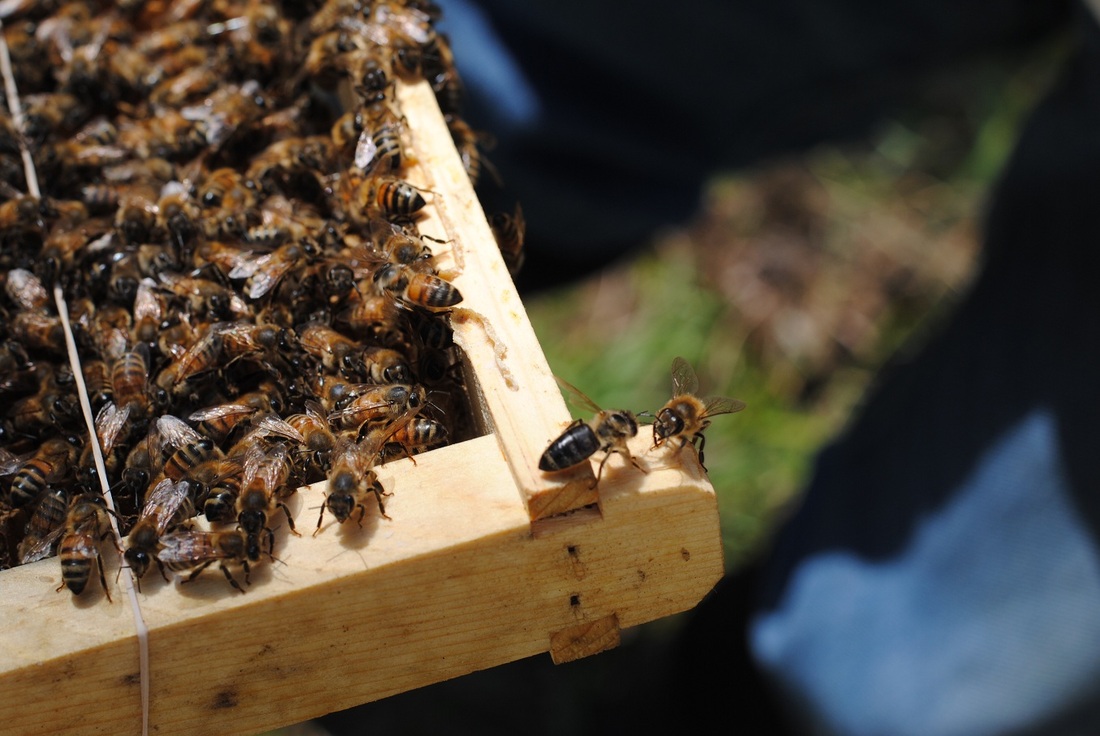
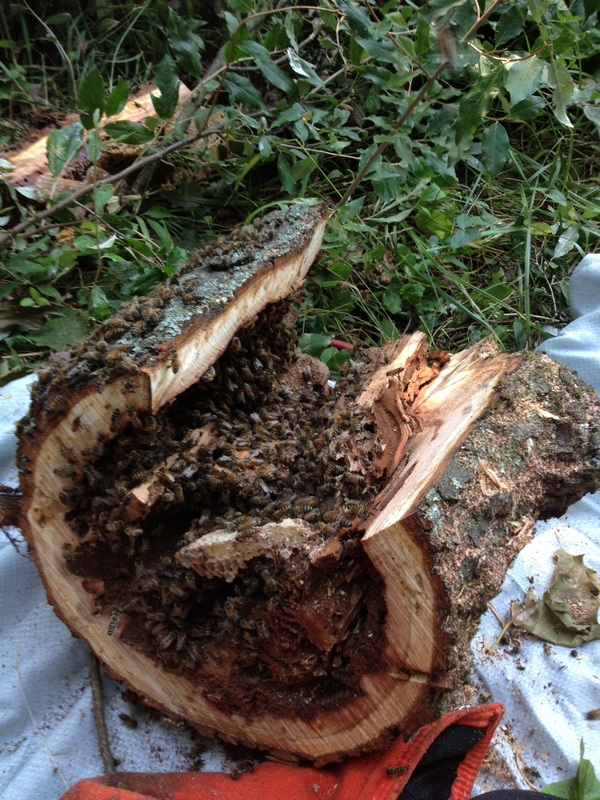
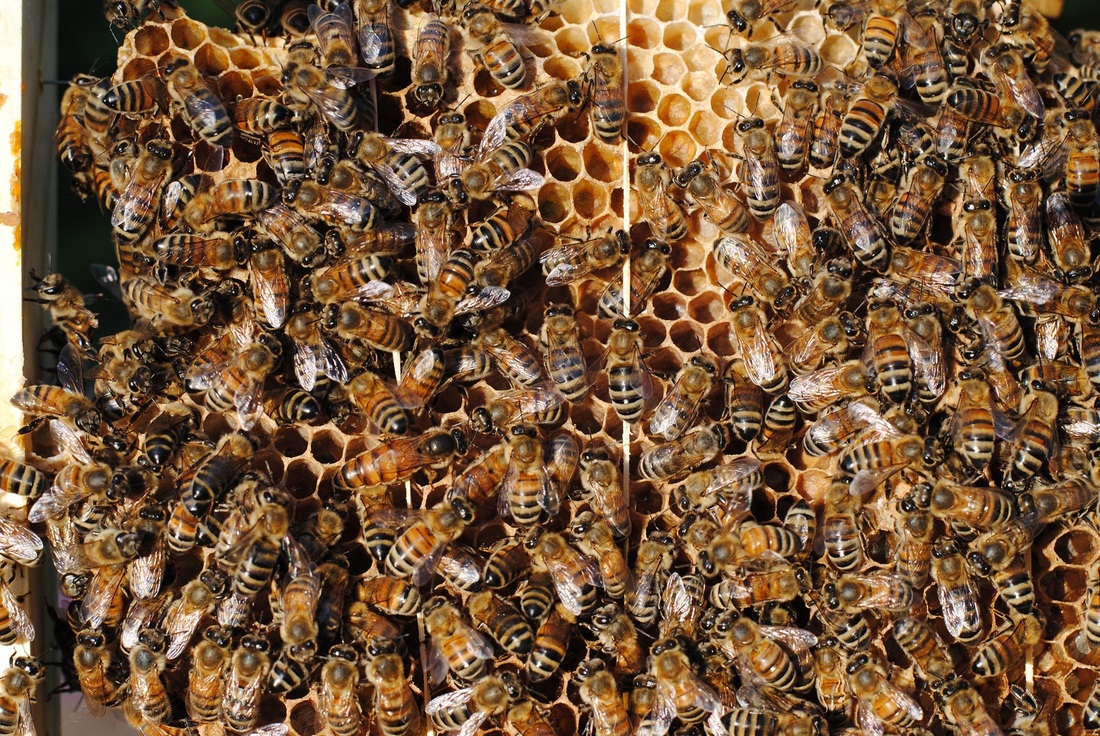

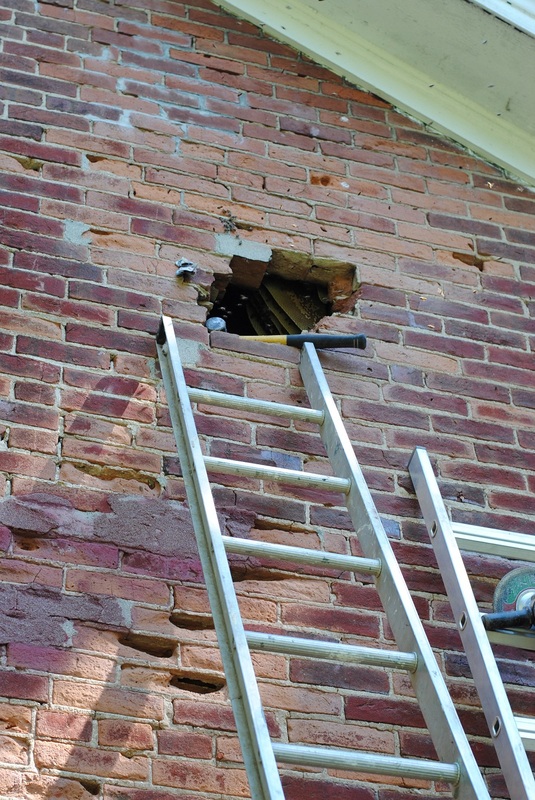
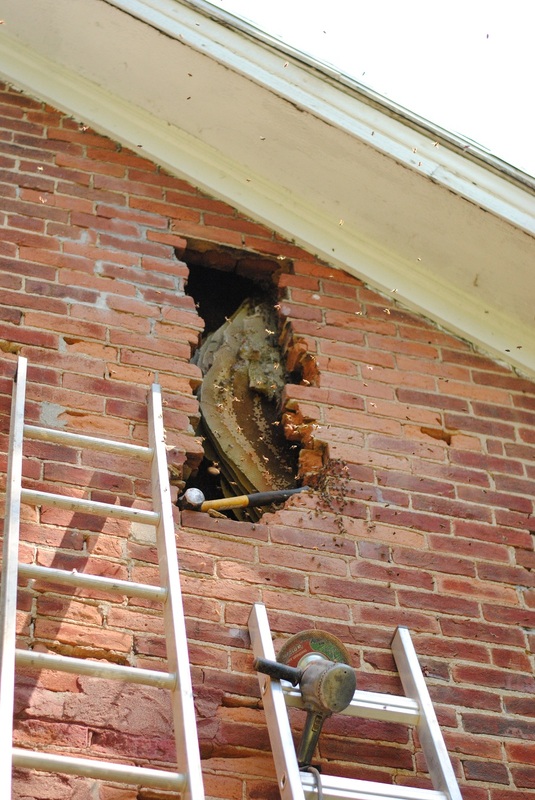
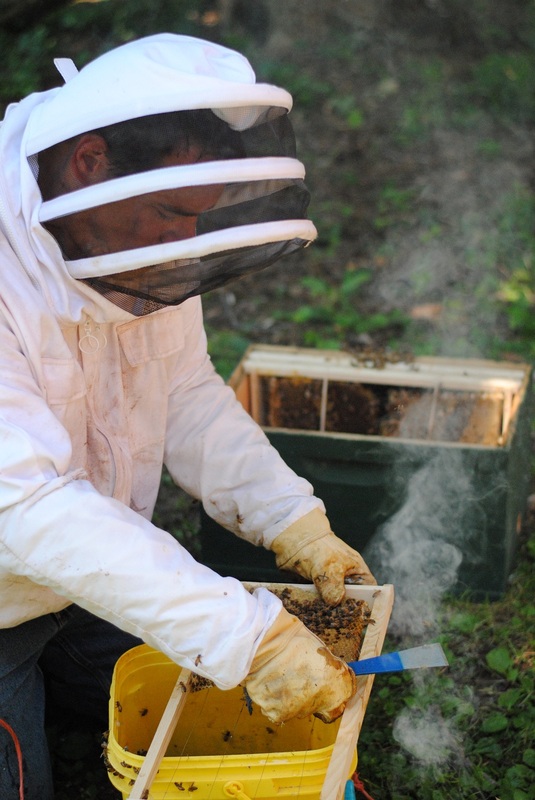


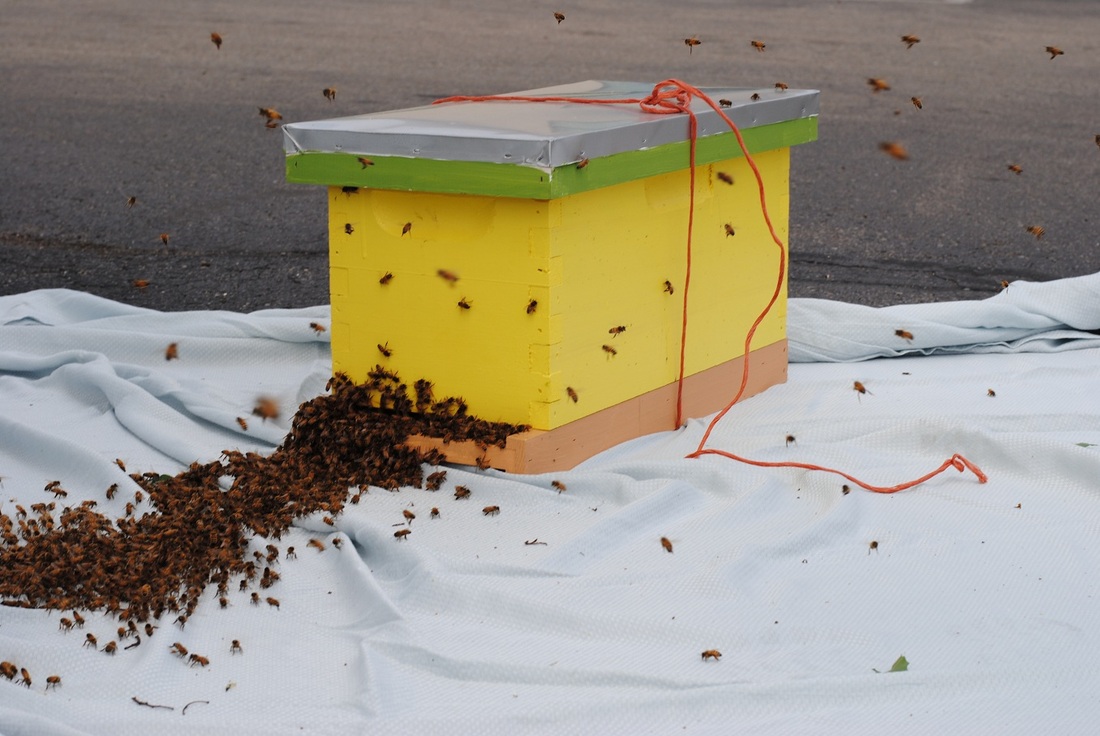
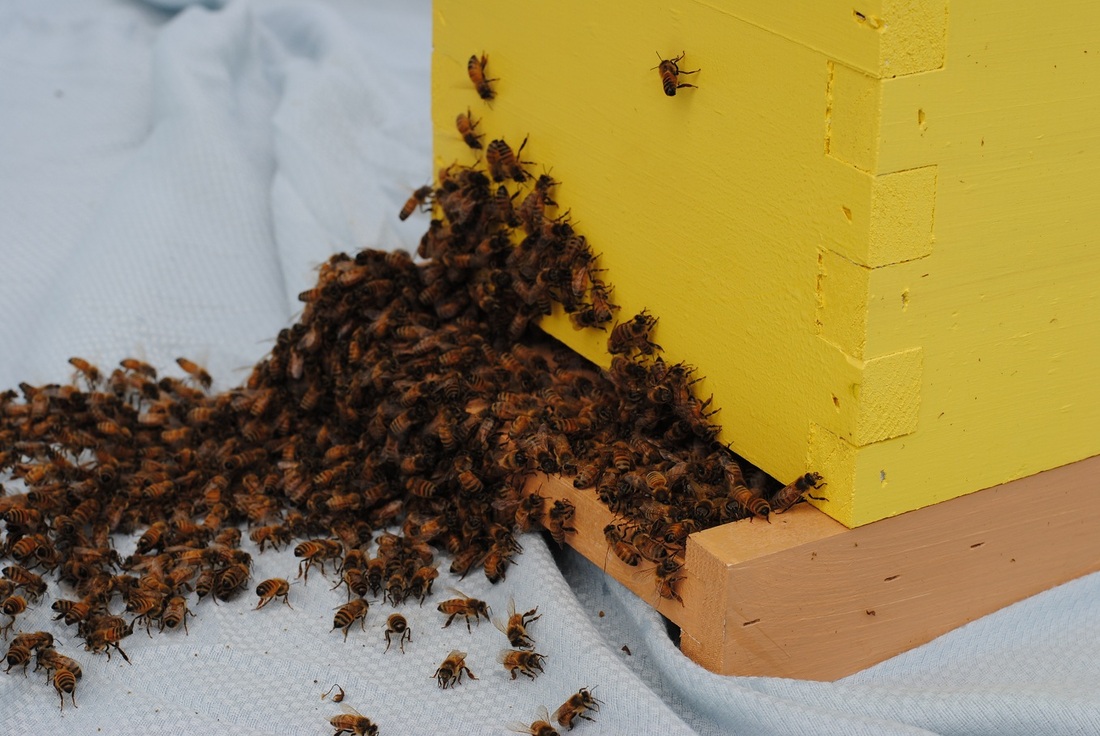

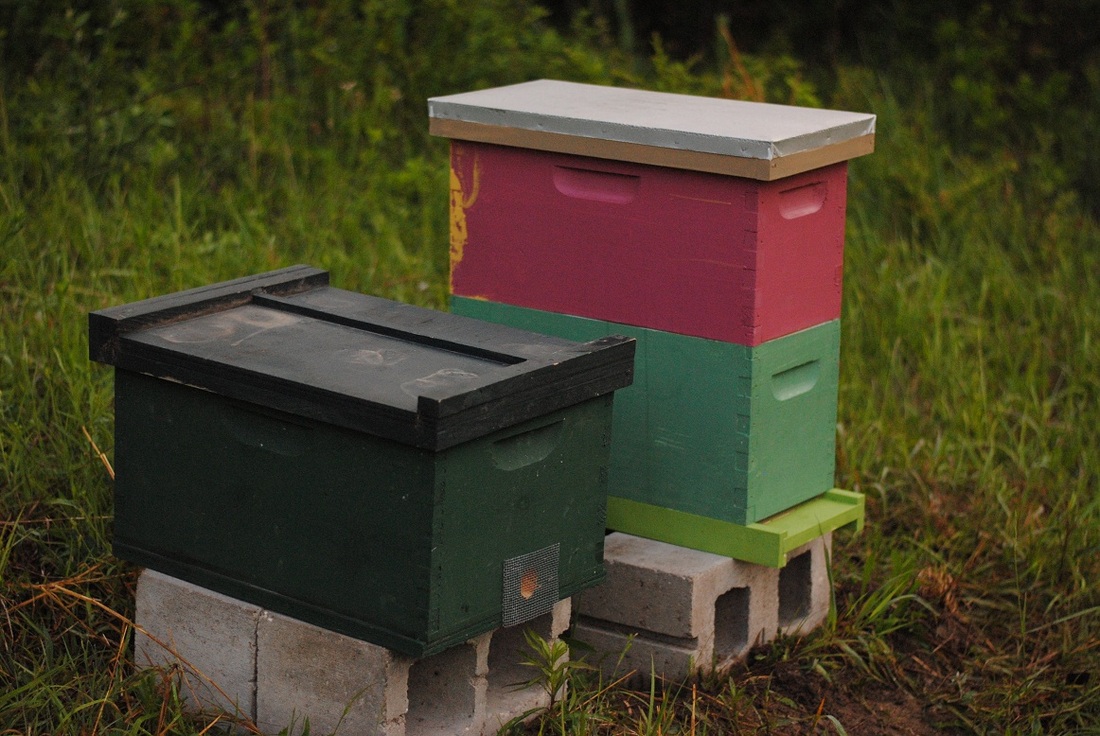
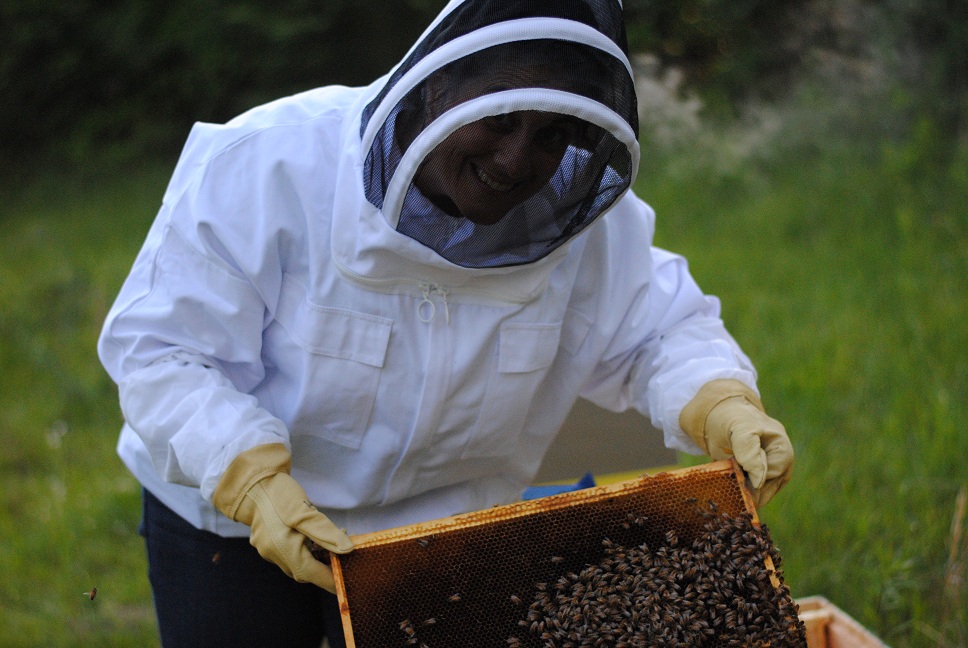
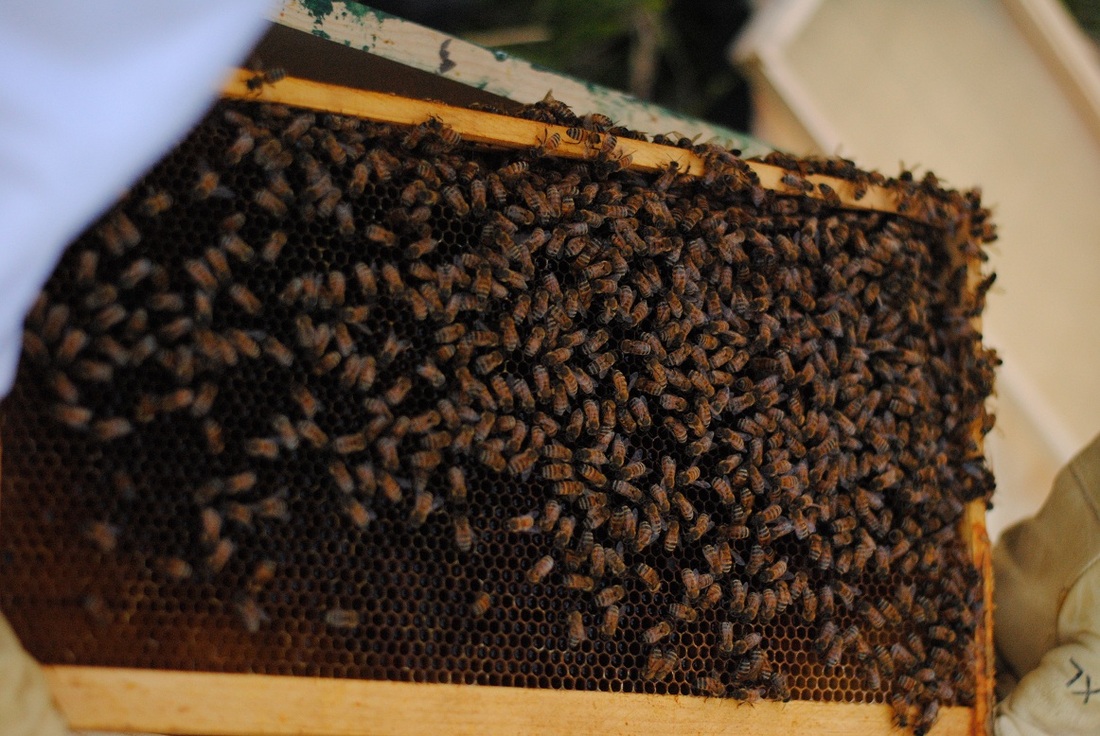
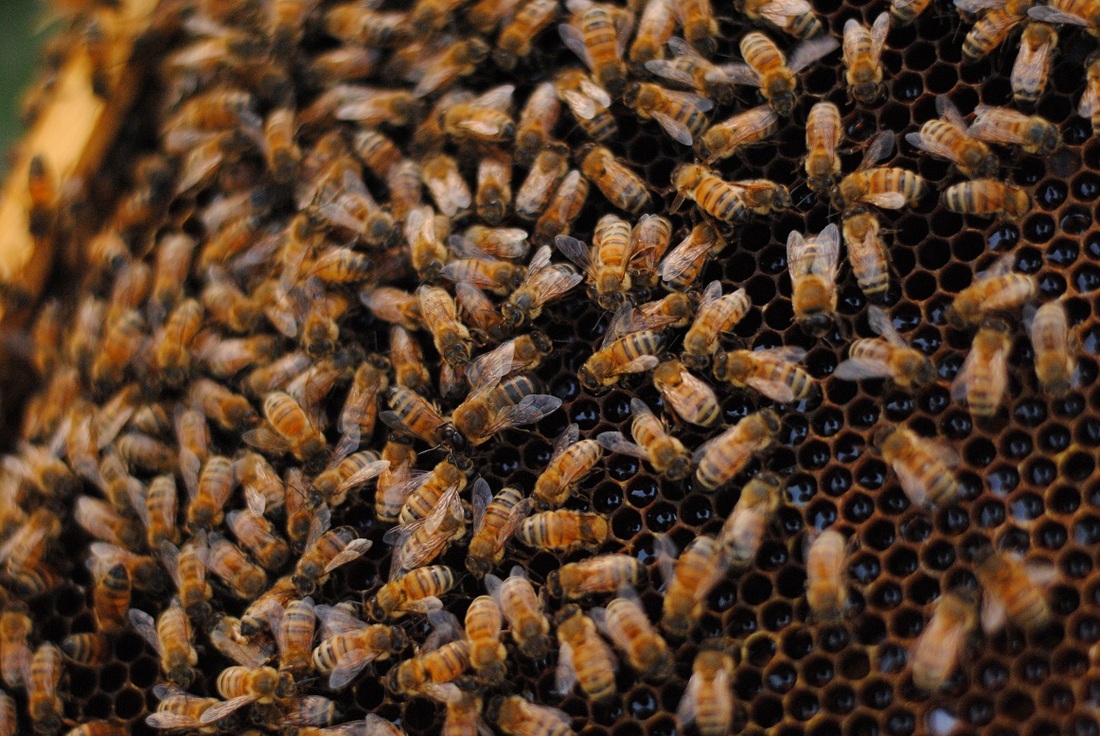
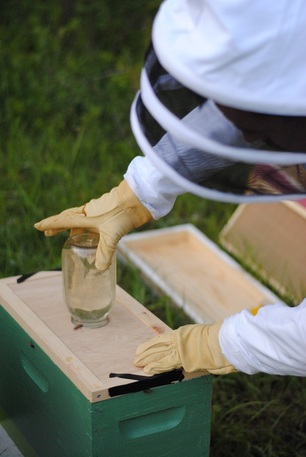

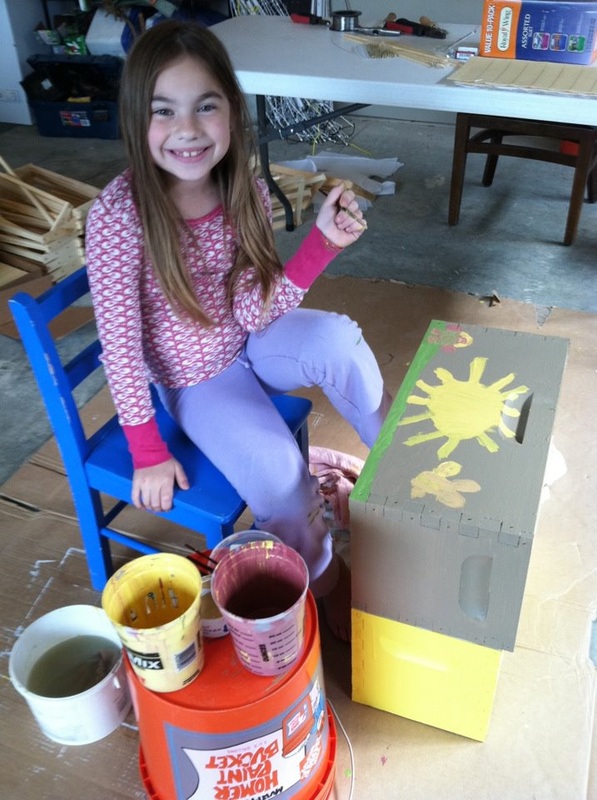
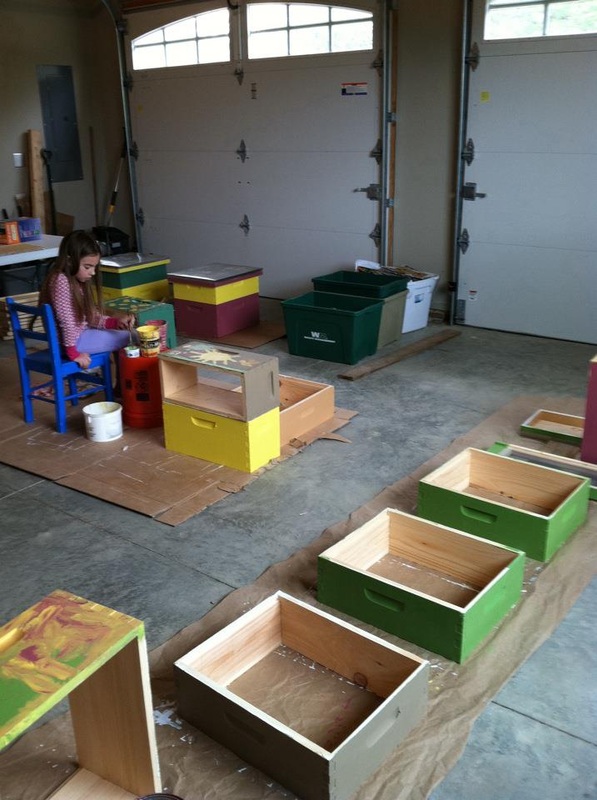
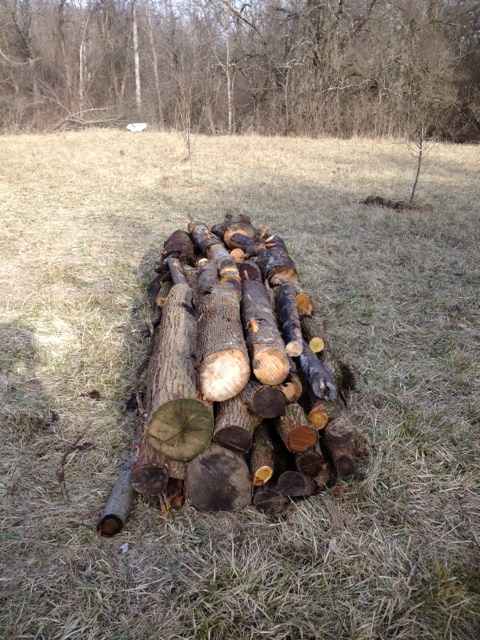
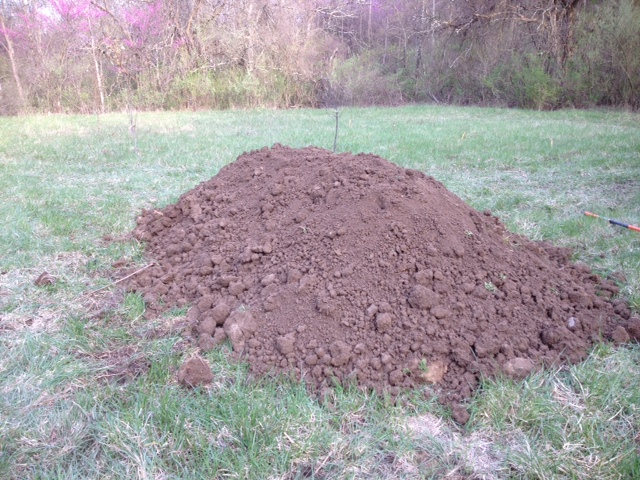
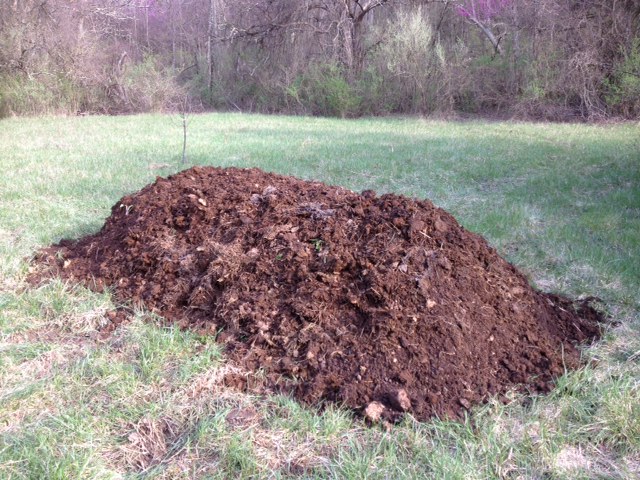
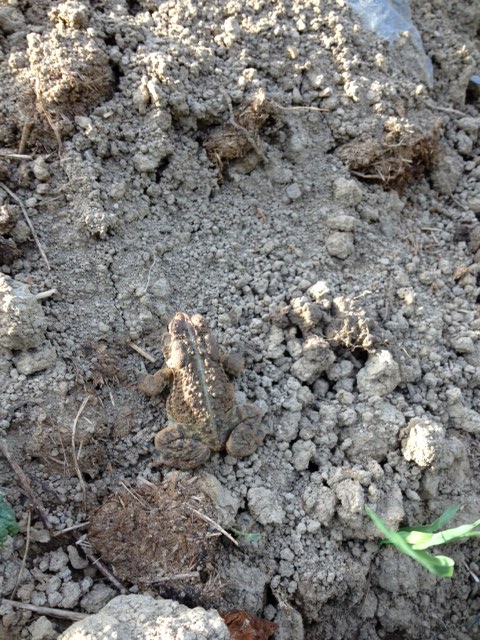
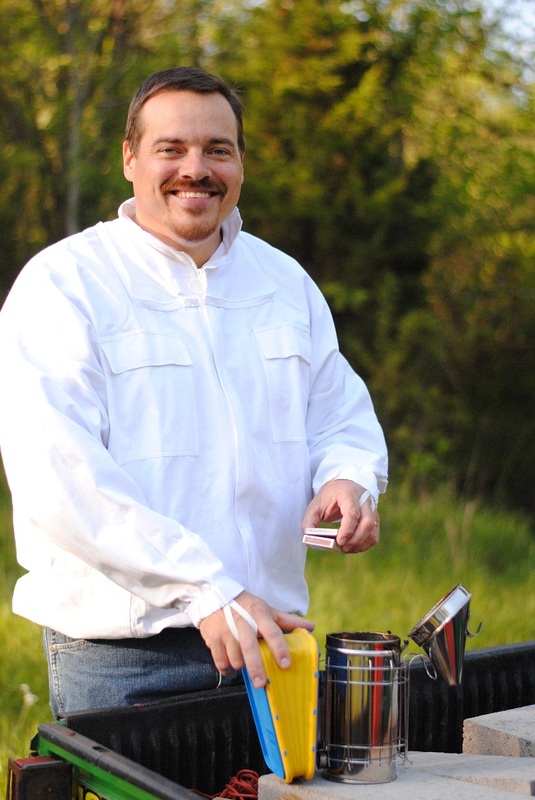
 RSS Feed
RSS Feed